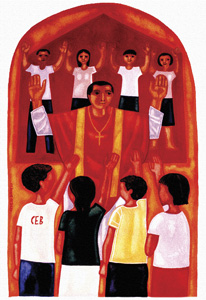Charismatic liturgies, with their lively music, mysticism, and strong community, offer the best of both worlds to Hispanic Catholics looking for a little more oomph in the Mass.
I was raised in a strict Pentecostal household and indoctrinated from an early age about the evils of the Catholic Church. I was taught that Catholicism was the furthest thing from spirituality, where God was nowhere to be found because saints and the Virgin Mary-referred to as "idols" in my family-dominated all worship, and Catholics served the pope instead of Jesus. The Eucharist was not seen as the Body of Christ but as a creation of the Catholic Church, and we should not have anything to do with it.
While for many this may sound absurd, I must confess that too many of my relatives still believe this. At many family gatherings I am lectured on how I have abandoned God for Catholicism, and should I die without repenting, my soul will be eternally condemned to hell. In fact, I had an uncle who was an evangelical preacher tell me I would be tossed into a hell seven times hotter than the original hell for abandoning God to become Catholic. Apparently my uncle, who passed away two years ago, believed God reserved the hottest level of hell for deserters like me since I should have known better. My new faith has been the hardest on my mother. Still very Pentecostal, she has trouble accepting that her daughter is condemned to spend eternity in hell.
Of course, I didn't convert from one religion to another. I spent almost 20 years without visiting any church. But I will never forget the guilt felt during my first visit to a Catholic parish in San Juan, Puerto Rico; it was as if I were betraying my family and everything I had been taught. I was in the midst of a personal crisis and felt the need to seek God. A Catholic friend, who knew I had been raised in a Pentecostal family, recommended I visit a charismatic church.
Over the years much has been said in favor of and against the Catholic charismatic movement. Many fear it is a faction within the church that is luring worshipers away from traditional Catholicism. But as early as 1969, a U.S. bishops' Committee on Doctrine report regarding charismatic renewal noted its "strong biblical basis" and legitimate theological reasons for existence. For many supporters, including me and other Latinos, the Catholic charismatic movement is another way to bring in the faithful.
On my first visit to this charismatic Catholic church, I sat in the back avoiding any eye contact, fearing it would signal I was a newcomer and would be harassed into conversion, a common practice in my family's church whenever a new face appears. If I had wanted such attention, I would have gone to church with any number of my relatives. Instead I was taken aback by the quiet and peace I felt as soon as I entered. Even the smell of burning candles was both appealing and ethereal. Candles were forbidden in my family's church.
Everyone was at prayer or gazing quietly at the altar. The quiet was gradually interrupted as members of the choir and music group, complete with guitars, maracas, tambourines, and palitos (wooden sticks), began taking their places in front. By that time most of the pews in the large church were filling up, providing me with a sense of relief. Now I would easily go unnoticed.
Mass began and everything was new yet familiar. The processional was festive; the priest smiled, waving at everyone as he advanced down the aisle toward the sanctuary to the tune of the upbeat rhythms; and from what I could see the musical director was dancing. This was certainly not the type of music I expected to hear at a Mass. I was taught Catholics were subdued when it came to worship and practicing their faith. Pentecostals, on the other hand, are filled with the Holy Spirit and it shows in the enthusiastic way they serve the Lord.
As Mass progressed, I had no idea when to stand and when to pray but was amazed at how everyone prayed together in one voice and knew just what was coming next. When it came time to pray the Lord's Prayer (which was first sung, then prayed), the people standing next to me grabbed my hands and raised them without asking, smiling when they saw my look of surprise. During the sign of peace, the priest came down the aisle shaking hands with everyone within his reach, while parishioners hugged, kissed on the cheeks, or shook each others' hands, many leaving the pews to embrace others who were beyond their reach.
For three months I visited the parish every Sunday. The music, singing, hugs, camaraderie, and the priest's energetic preaching kept me coming back. In no time, I was the first to grab the hands of others and lift them up in prayer. On the fourth Sunday of every month, the parish celebrated a healing Mass in honor of the Holy Divine Child Jesus and the church was filled to capacity. It was standing room only as hundreds of devotees packed into the church to pray, place their petitions in a basket, or lay flowers at the feet of a large statute of the child Jesus in the sanctuary. Testimonies of the healings and miracles attributed to the Divine Child were read by the priest at the end of Mass, and the faithful broke into a thunderous applause after each one. It was easy to be swept away by such enthusiasm and faith.
The best part was no one pressured me to become Catholic. At the end of my third month, I made an appointment to see the priest and began my 12-month journey to the sacraments. I received my First Communion on Christmas morning. "You will be born on the same day as Jesus," my pastor said as he prepared me. No one from my family was present. The priest called me to the altar, announced to everyone it was my First Communion, and proceeded to give me the Body of Christ. When Mass ended parishioners came to bless me (blessing others, especially our children, is very common among Hispanics) and congratulate me.
Swept away by the charismatic energy and excitement found in this church, I can't help but think of Hispanics who have left the Catholic Church because it was, let's just say, less than exciting and who would probably return if they attended Mass in a charismatic church. For Hispanics, who must live between two cultures, charismatic Catholicism can offer the best of both worlds: participation in the sacraments and a personal, livelier form of worship, which is at the heart of our religious experience.
And just what does it mean to be charismatic? It means to share in the elation often found among evangelical Christians. It is a Mass infused with energy, where those "baptized" with the Holy Spirit are said to speak in tongues (although I have yet to see it in my parish) and where faith in the power of prayer and healing is strong. Some charismatic experiences-such as receiving the Holy Spirit, described by many as a feeling of extreme joy, and speaking in tongues-are not as prevalent as its critics believe. The prayer groups, fervor, emphasis on transforming our lives, greater participation, and the spiritual connection felt entre los hermanos are what appeal most to Hispanics from the charismatic style of worship.
Some evangelicals view charismatic Catholics with suspicion and suspect them of deceiving their own followers into joining Catholicism. For non-charismatic Catholics such forms of worship are often perceived as Hispanics creating "parishes within parishes." Speaking in tongues, putting our hands up in the air, dancing and enthusiastically expressing joy make some traditional Catholics more than a little uncomfortable.
"The Pentecostalism and ecumenism presently gripping our Holy Church could be nicknamed ‘Luther's Conquest,' " wrote John Vennari in Catholic Family News in 1997, on the 30th anniversary of the charismatic movement. "It is not only our duty to resist it, but also to beseech heaven on behalf of the ‘Catholic charismatic' who prays with his hands in the air and his foot on the throat of traditional Catholic doctrine and practice."
It is hard for me to conceive that practicing a charismatic form of Catholicism is equivalent to being a bad Catholic. On the contrary, charismatic worship makes many followers stronger Catholics, as it makes us feel closer to God. The Mass is still the center of our lives and we have not abandoned our devotion and love of Mary.
For Latinos, Catholicism is more than just our religion; it is a way of life with the most significant moments of our lives-births, marriage, quinceañeras, illness, and death-deeply connected with Catholicism. In Latino homes you are more than likely to find an image of the Sacred Heart, Virgin Mary, and our favorite saints hanging on the wall or adorning an altar. For many Latinos, far from our families and loved ones, the church provides us with the closest thing to the kinship we had in our homelands.
But those faithful to the traditional Catholic Church need not be alarmed. While Latinos place great emphasis on having a unique personal experience with God, we are still very much committed to the church, its traditional teachings, and the sacraments, and have no intention of doing away altogether with traditional liturgy. Most Latino Catholics are just seeking a strong relationship with Jesus and prefer to be active participants in God's work and not just spectators at Mass.
As the number of Hispanics in the U.S. Catholic Church continues rising, we are likely to see greater growth in some forms of charismatic worship. In 2007 the Pew Forum on Religion and Public Life reported that already one third of all Catholics in the United States are Latinos. While the news of our growing numbers was welcomed by many Catholics, it made others apprehensive, realizing demographics and the distinctive characteristics of Latino worship would bring about changes in the U.S. church.
But the truth is that Latinos already have made an imprint on the U.S. Catholic Church and changes are well under way. In many parishes Spanish Mass is no longer optional; the demand for clergy fluent in Spanish has substantially increased; the need for Hispanic ministry can no longer be ignored; and the fact that, according to Pew's findings, 54 percent of Latino Catholics say they are charismatic makes it difficult to ignore our impact on the U.S. church. Blessed Carlos Manuel Rodríguez, a Puerto Rican, is the first lay U.S citizen to be beatified by the Catholic Church.
There's little doubt that as the U.S. church becomes more predominantly Hispanic, the percentage of charismatic Catholics will increase. While I often hear that the Catholic Church may be falling out of touch with its followers, it seems Latinos have discovered a way to stay connected. In our own unique way, we have made the church more personal and spiritual, with a distinctive style of worship that reflects what we experience in our native countries.
When I moved to Chicago, I was pleased to discover my parish celebrated a spirited Mass in Spanish and has a charismatic renewal group. It has incorporated some of the aspects of charismatic worship, including lively singing and music, where many lift their arms in prayer, where the feasts of Nuestra Señora de la Divina Providencia and Nuestra Señora de Guadalupe are major celebrations, with prayer groups and adult Bible studies, and where every Sunday visitors are welcomed with applause at the end of Mass. It is also a parish where the pastor comes down from the sanctuary to give others the sign of peace, an act often frowned upon by some Catholics but seen by Latinos as a special gesture or blessing providing a spiritual connection between the faithful and their priest.
So if you wish to observe firsthand what the growth of Latinos and our charismatic style of worship may mean for the U.S. Catholic Church, I invite you to visit my parish or any number of parishes in Hispanic communities throughout the nation for a personal, up-close experience.
Scholars say the Catholic charismatic movement is one of the outcomes of Vatican II. I have no idea how the Catholic Church was prior to Vatican II; all I know is that the spirited church I encountered, and the one I have learned to love and serve, seems to be what many Latinos are seeking. It is also just what I spiritually need.














Add comment